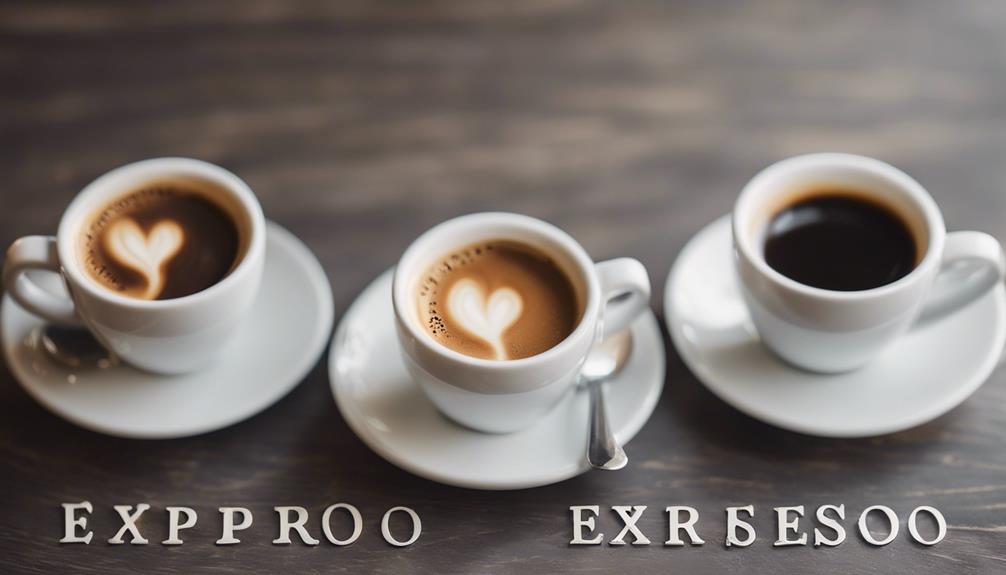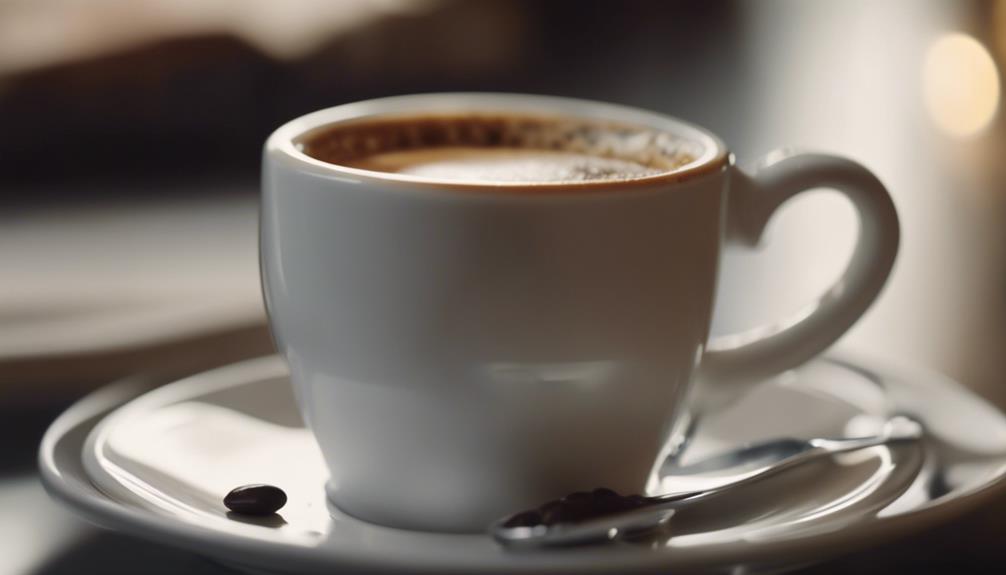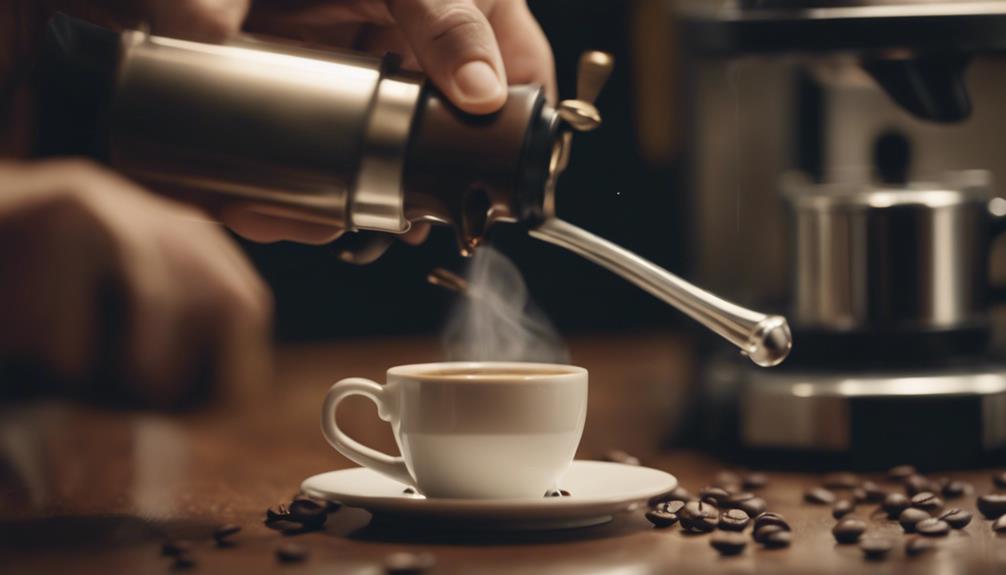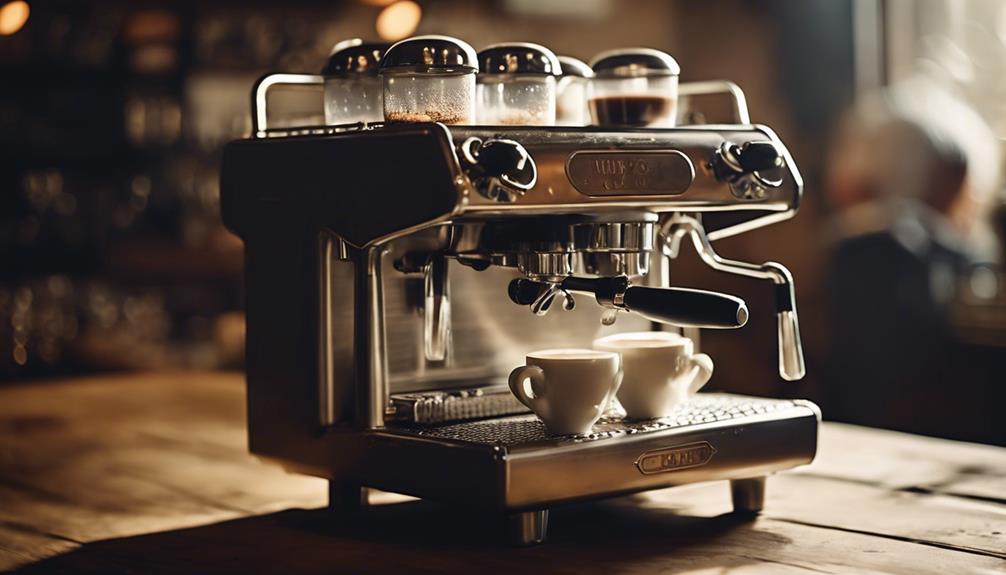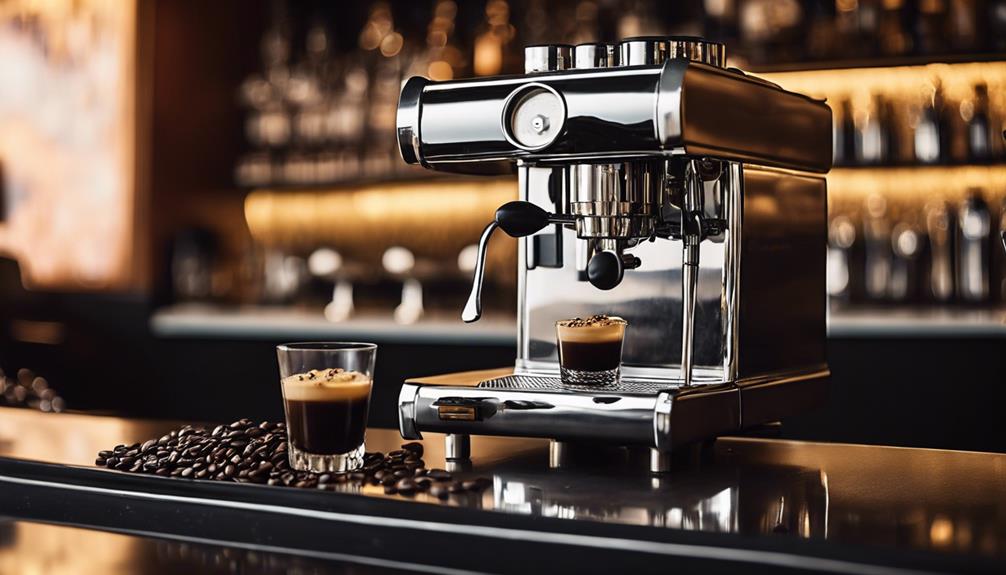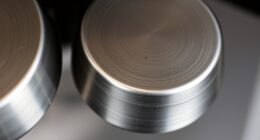To properly spell it, it’s ‘espresso’, originating from Italian for ‘pressed-out coffee’. ‘Expresso’ is a common misspelling influenced by French pronunciation. Pronounce it emphasizing the ‘es’ in ‘espresso’. Knowing the correct emphasis is crucial. ‘Espresso’ holds historical significance from late 19th-century Italy. The term ‘espresso’ describes a rapid process, forcing hot water through finely-ground coffee, resulting in a concentrated brew. While ‘expresso’ is a debated variation, sticking to ‘espresso’ is considered more precise. Understanding the linguistic subtleties pays homage to Italian coffee culture.
Key Takeaways
- 'Espresso' is the correct spelling and pronunciation, emphasizing the 'es' for accuracy.
- 'Expresso' is a common misspelling influenced by French pronunciation, but 'espresso' is the standard term.
- Understanding the etymology and cultural significance of 'espresso' aids in proper usage.
- Proper pronunciation honors Italian coffee culture and heritage, distinguishing 'espresso' from 'expresso'.
- Avoid confusion by recognizing 'espresso' as the accurate term and pronunciation in coffee terminology.
Origins of Espresso Term
Frequently, the term 'espresso' traces its origins back to Italy, particularly Luigi Bezzera of Milan. Early theories linked 'espresso' to the Latin word 'esprimere,' meaning to press or squeeze out.
However, current etymology suggests that 'espresso' actually refers to coffee made on the spot for the customer. It's noteworthy that the method of delivery, rather than pressing out the coffee, is likely the true origin of the term 'espresso.'
While 'espresso' is the widely accepted spelling, the quirky variant 'expresso' has also gained some recognition over time, even making its way into dictionaries due to its usage. Despite this, 'espresso' remains the standard term used globally to refer to the beloved concentrated coffee drink.
Linguistic Distinction: Espresso Vs. Expresso

Understanding the difference between 'espresso' and 'expresso' is essential for coffee enthusiasts and linguists alike. 'Espresso' is the correct term, derived from the Italian word for "pressed out." On the other hand, 'expresso' is a common misspelling that has gained popularity, particularly in English-speaking countries. Linguistic experts attribute the use of 'expresso' to a variant influenced by French pronunciation.
To clarify the distinction further, let's compare 'Espresso' and 'Expresso' in the table below:
| Term | Origin |
|---|---|
| Espresso | Italian |
| Expresso | Misspelling |
The ongoing debate surrounding 'espresso' versus 'expresso' showcases the evolution of language and the impact of cultural influences on vocabulary. By recognizing the etymology and correct pronunciation of 'espresso,' individuals can accurately navigate the world of coffee terminology and appreciate the rich linguistic history behind their favorite beverage.
Correct Pronunciation of Espresso
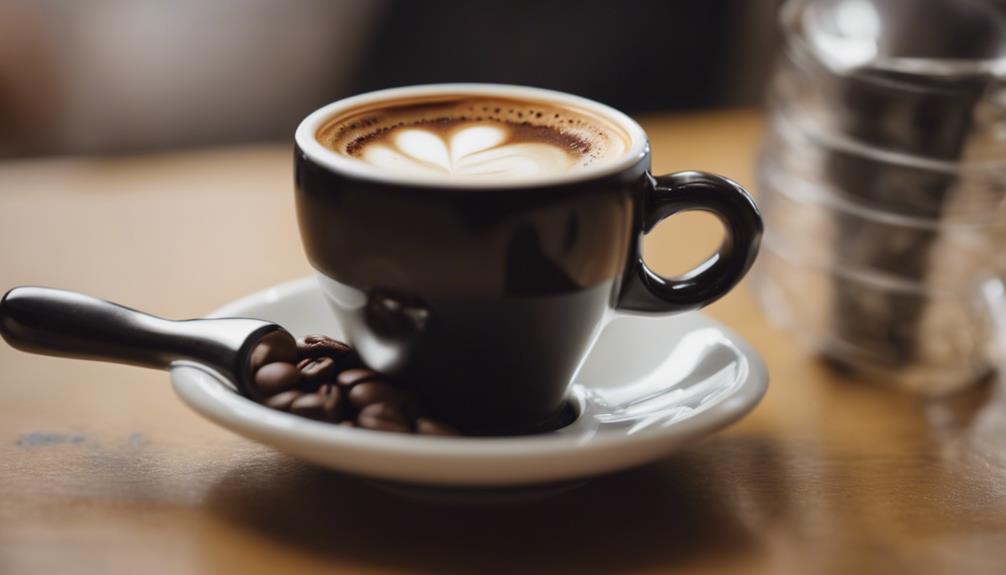
Mastering the pronunciation of 'espresso' with the correct emphasis on the first syllable is essential for coffee aficionados and linguistic enthusiasts. The term 'espresso' is of original Italian descent, stemming from the word 'esprimere,' which translates to 'to press or squeeze out.'
Pronouncing espresso as 'expresso' is a common misspelling that often prompts corrections from baristas, especially in English-speaking regions. By pronouncing it correctly as 'espresso,' you not only adhere to the original Italian pronunciation but also show respect for the language and cultural heritage associated with the drink.
The emphasis on the correct pronunciation of 'espresso' serves to maintain accuracy in coffee terminology and honors the significance of espresso in Italian coffee culture. Embracing the proper pronunciation showcases a dedication to preserving the authenticity and traditions linked to this beloved beverage.
Historical Significance of Espresso
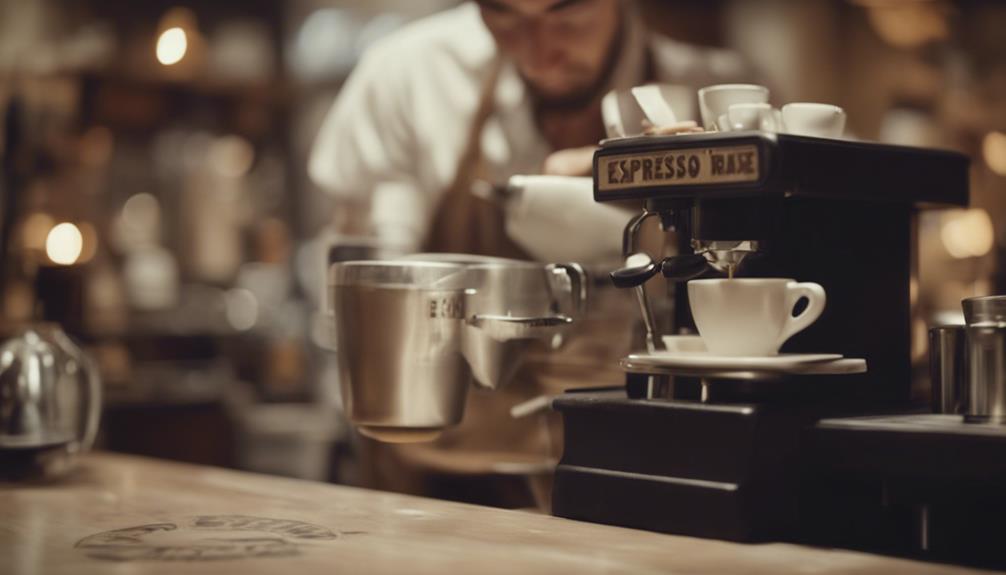
Espresso holds a rich historical significance, tracing back to its Italian roots in the late 19th century. Luigi Bezzera's invention revolutionized coffee-making, giving birth to the espresso that's familiar to us today.
This beverage has evolved over time, becoming an integral part of Italian coffee culture and gaining widespread popularity worldwide.
Espresso Origins
With its origins rooted in Italy, the historical significance of espresso dates back to the late 19th century. The word 'espresso' comes from the Italian phrase 'caffè espresso,' which translates to 'pressed-out coffee.' The first espresso machine was patented in 1884 by Luigi Bezzera of Milan, marking a pivotal moment in the history of coffee.
Espresso holds a special place in Italian culture and has become a beloved drink worldwide for its robust flavor and high caffeine content. In Italy, ordering an espresso isn't just about the beverage itself but also a cultural experience that celebrates tradition and craftsmanship.
Understanding the Italian origins of espresso is essential for appreciating the drink's heritage and significance. By pronouncing and spelling 'espresso' correctly, you honor the rich coffee culture of Italy and pay homage to the craftsmanship and passion that go into making this iconic beverage.
Espresso Evolution
Pivoting from the historical origins of espresso, the evolution of this iconic coffee beverage showcases its enduring cultural significance and worldwide popularity.
The term 'espresso' has a rich history, originating in Italy in the late 19th century. Luigi Bezzera of Milan is credited with inventing the espresso-making method that has become a cornerstone of coffee culture globally.
Espresso's journey from its Italian roots to international fame highlights its unique taste and strong aroma that have captivated coffee enthusiasts. Despite its correct pronunciation emphasizing the first syllable, the alternate spelling 'expresso' is commonly used in English-speaking regions, leading to occasional confusion among consumers.
Baristas play an important role in educating customers on the correct terminology, emphasizing the significance of using the word 'espresso' accurately. Understanding the linguistic roots of 'espresso' deriving from the Italian word 'exprimere,' meaning to squeeze out, adds depth to one's appreciation for this beloved coffee beverage.
Espresso Cultural Impact
The historical significance of espresso in shaping coffee culture is undeniable. This Italian tradition, with its rich and bold flavor, has left a lasting impact on how we enjoy coffee worldwide. When ordering an espresso, the correct pronunciation is essential to honor the heritage of this beloved beverage. Espresso machines, designed for quick preparation, have become iconic symbols of efficiency and craftsmanship.
| Espresso Facts | Impact on Coffee Culture |
|---|---|
| Invented by Luigi Bezzera | Revolutionized the way we enjoy coffee |
| Deeply rooted in Italian tradition | Respected globally for its unique flavor |
| Correct pronunciation vital | Carries cultural significance, honoring Italian heritage |
| Espresso machines iconic symbols | Symbolize efficiency and quality in coffee preparation |
| Honoring cultural heritage | Correct pronunciation is a sign of respect for espresso legacy |
Common Misconceptions About 'Expresso'

Many people mistakenly believe that 'expresso' is an acceptable alternative spelling for 'espresso'. However, according to language experts, 'expresso' is considered a misspelling of 'espresso'.
While some dictionaries may list 'expresso' as a variant spelling, it's generally viewed as incorrect. The term 'expresso' likely originated as a phonetic error in English-speaking countries, leading to its common but mistaken use.
Language purists advocate for using the correct term 'espresso' to respect its Italian origin and maintain linguistic accuracy. In formal writing, using 'expresso' instead of 'espresso' may be seen as a spelling mistake.
It's important to note the distinction between these two terms to guarantee proper communication and adherence to language conventions.
Etymology of 'Espresso' and 'Expresso'
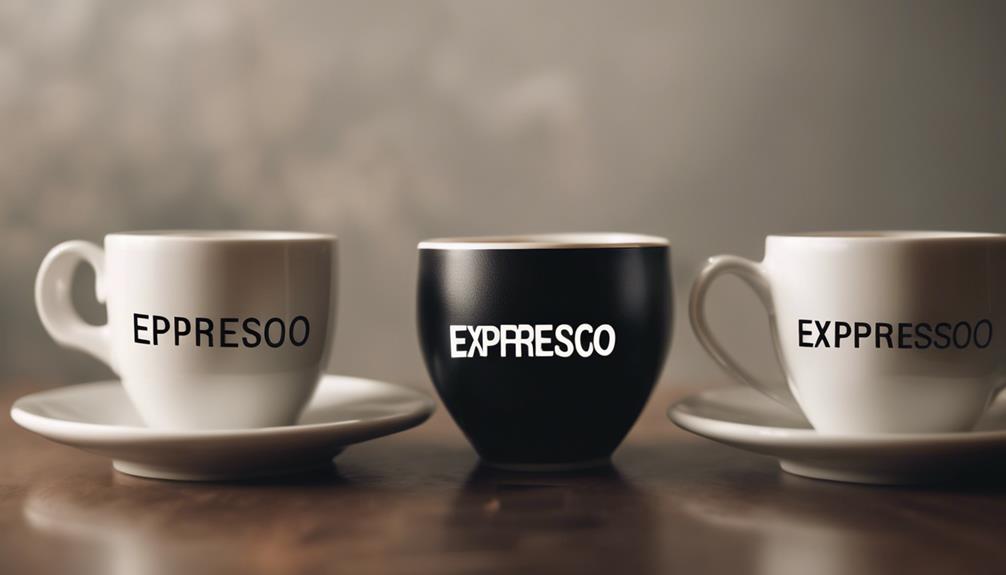
The etymology of 'espresso' traces back to Italy. It originated from the term 'caffè espresso,' meaning pressed coffee. Some early theories suggested its roots in the Latin word 'esprimere,' which means to press or squeeze out.
While 'expresso' is often seen as a misspelling, it has found its place in certain linguistic contexts.
Word Origins
Originating from the Italian term 'caffè espresso,' the etymology of 'Espresso' and 'Expresso' reflects the evolution of coffee culture and language.
The word 'espresso' specifically refers to coffee prepared by forcing hot water through finely-ground coffee beans. This method results in a concentrated and flavorful brew, known for its rich taste and strong aroma. The use of the term 'espresso' highlights the rapidity of the preparation process, emphasizing its quick production compared to traditional coffee brewing methods.
On the other hand, the variant 'expresso' has sparked debates among language enthusiasts due to its deviation from the original Italian term. While some dictionaries now acknowledge 'expresso' as an alternative spelling, purists maintain that 'espresso' is the correct form.
The French pronunciation influence on 'expresso' can be attributed to phonetic challenges in articulating the Italian 's' sound at the beginning of the word. Despite its contentious status, 'expresso' continues to be used by individuals who may not be familiar with the traditional spelling.
Pronunciation Clarification
When pronouncing 'Espresso' and 'Expresso,' it's crucial to emphasize the correct stress on the first syllable to stay true to the Italian origins of the word.
The pronunciation is 'e-SPRESS-o,' not 'ex-PRESS-o.'
To guarantee you're correctly pronouncing this beloved coffee style, follow these guidelines:
- Correct Stress: Emphasize the 'es' in 'espresso' to honor its Italian roots.
- Italian Influence: Remember the Italian phrase 'caffè espresso,' meaning pressed coffee, highlighting the method of preparation.
- Linguistic Evolution: Recognize that 'expresso' has emerged as a common misspelling in English, but 'espresso' is the accurate term.
Understanding the etymology of 'espresso' from the Italian word 'esprimere,' meaning to press out, sheds light on the correct spelling and pronunciation.
Common Misspellings
To avoid confusion between 'espresso' and 'expresso,' remember that the correct spelling honors the Italian roots of the word. While 'espresso' is the standard term, 'expresso' often sneaks in as an alternate spelling due to its resemblance to the English word 'express.' However, to stay true to the origins of this beloved coffee beverage, it's best to use the word 'espresso.'
To highlight the common misspelling and the correct form, refer to the table below:
| Common Misspelling | Correct Spelling |
|---|---|
| Expresso | Espresso |
| Expresso | Espresso |
| Expresso | Espresso |
| Expresso | Espresso |
| Expresso | Espresso |
When discussing Espresso machines or ordering your favorite espresso drink at a cafe, using the accurate term 'espresso' not only demonstrates your knowledge of the beverage but also pays homage to its Italian heritage.
Cultural Impact of Espresso Terminology
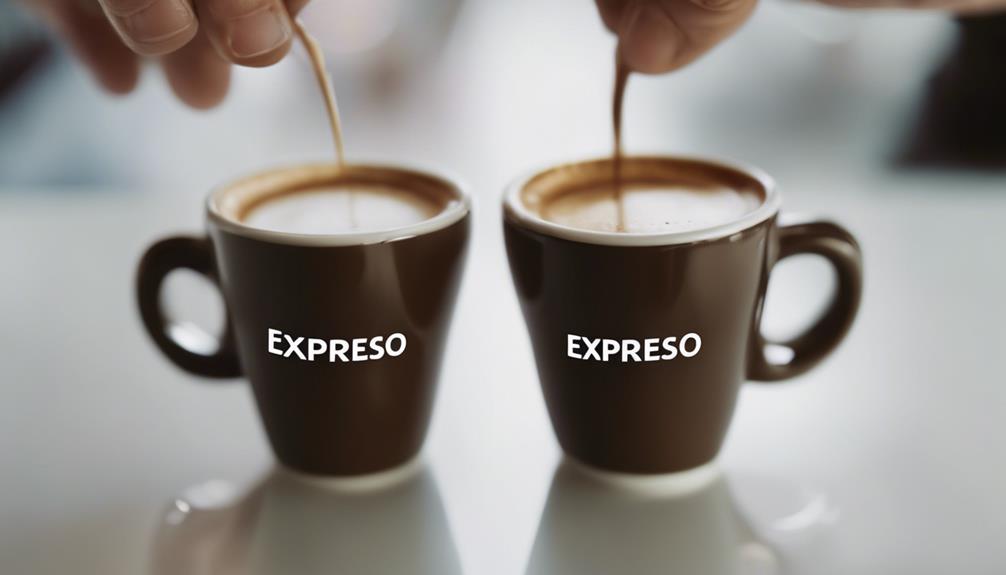
Respecting the cultural heritage of Italian coffee culture entails understanding the significance of correctly pronouncing 'espresso' when ordering this beloved beverage.
The term 'espresso' originates from Italy, reflecting the rich cultural heritage of Italian coffee culture. When you order an espresso in Italy, using the correct pronunciation is essential to show respect for the tradition.
The correct pronunciation of 'espresso' emphasizes the first syllable, aligning with Italian linguistic nuances. Baristas often correct customers who mispronounce 'espresso' as 'expresso' to maintain accuracy in coffee terminology.
Upholding the original term 'espresso' honors the cultural significance associated with this beloved beverage worldwide.
- Rich Heritage: 'Espresso' reflects the deep-rooted Italian coffee culture.
- Respect Tradition: Pronouncing 'espresso' correctly is a sign of respect for the Italian coffee tradition.
- Cultural Significance: Upholding the term 'espresso' maintains the cultural significance of this iconic beverage.
Frequently Asked Questions
Is It Pronounced Expresso or Espresso?
When it comes to the pronunciation of this coffee classic, it's important to say 'espresso,' emphasizing the first syllable.
'Expresso' is a common mistake made in English-speaking areas. Baristas often politely correct customers who use 'expresso' instead of the correct 'espresso.'
Using the accurate term 'espresso' guarantees adherence to coffee terminology standards and respects the nuances of the Italian language in which the word originates.
Why Do People Say Expresso Martini?
People say 'Expresso Martini' instead of 'Espresso Martini' due to a common mispronunciation. The similarity in sound between 'expresso' and 'espresso' might lead to confusion, especially since the drink contains espresso as a key ingredient.
Is It Espresso or Expresso Machine?
When selecting a coffee machine, choose an 'espresso' machine, not an 'expresso' one.
An 'espresso' machine is designed specifically for making the popular coffee type by forcing hot water through finely ground beans.
The term 'espresso' is the correct spelling and pronunciation, emphasizing the first syllable.
Using an 'espresso' machine guarantees you can enjoy a perfect cup of this Italian favorite at home.
Do They Say Espresso in Italy?
In Italy, they say 'espresso.' Ordering an 'espresso' there's a common practice. The term 'espresso' comes from 'caffè espresso,' meaning 'pressed coffee.'
It's pronounced with emphasis on the first syllable. Choosing 'espresso' aligns you more with Italian coffee traditions.
What is the correct spelling and pronunciation of “espresso” and “doppio espresso”?
The correct spelling and pronunciation of “espresso” is es-press-soh, and “doppio espresso” is dopp-ee-oh es-press-soh. The doppio espresso uniqueness lies in its double shot, making it stronger and more flavorful than a regular espresso.
Is Lungo a Type of Espresso and How is it Different from Regular Espresso?
Yes, Lungo is a type of espresso, but with a larger water volume. The keyword “lungo vs espresso differences” lies in the extraction time and flavor profile. Lungo takes longer to brew, resulting in a more diluted, milder taste compared to the intense, concentrated flavor of a regular espresso.
Conclusion
To sum up, knowing how to spell and pronounce 'espresso' correctly isn't just a matter of linguistic precision, but also a nod to the rich history and cultural significance of this beloved coffee beverage.
So next time you order your favorite espresso drink, remember to say it right – with an 's' not an 'x'.
Just like a well-brewed espresso, getting the pronunciation right adds that extra touch of authenticity to your coffee experience.
